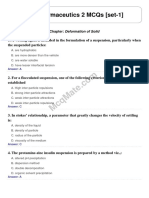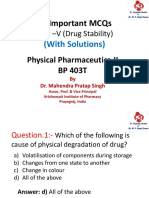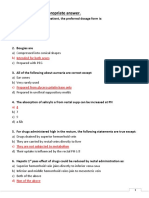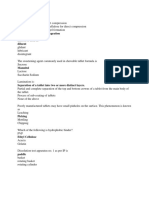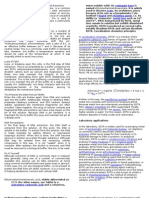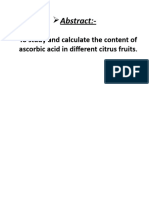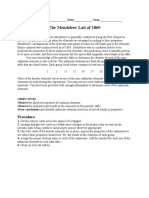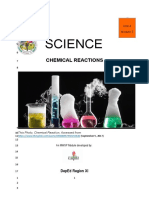CAPSULES QUESTIONS
SECTION A
1. One of the statements relating to hard gelatin capsules is FALSE. Which one?
A. Used as dosage forms of powders and granules
B. Consists of a cap and a body
C. Used to dispense fat soluble vitamins
D. The texture is harder than soft gelatin capsules
2. The soft shell used in capsule manufacture is composed of the following, EXCEPT:
(i) Gelatin, acacia and water
(ii) Gelatin, glycerol and water
(iii) Gelatin, plasticizer and water
A. (i) only
B. (ii) and (iii) only
C. (i) and (iii) only
D. (iii) only
3. All the statements given below are true about hard gelatin capsules EXCEPT:
A. Consist of two portions, the cap and the body
B. Used for filling powders or granules
C. Are hermetically sealed
D. The capsule shell contains gelatin, preservatives and water
4. Which of the following dosage forms cannot be filled in hard gelatin capsules?
A. Semi-solid preparations
B. Powders
C. Granules
D. Pellets
5. Which of the following statements is FALSE about soft gelatin capsules?
A. Contains plasticizers in the shell
B. Contains preservatives in the shell
C. Used for packaging aqueous liquid dosage forms
D. They are hermetically sealed
6. Which of the following quality control tests is not subjected to hard gelatin capsules?
A. Uniformity of weight
B. Disintegration test
C. Assay of active ingredient
D. Friability test
�7. The following compounds may all be employed as plasticizers in the manufacture of
capsule shells, except:
A. fumed silica
B. sorbitol
C. glycerine
D. propylene glycol
8. Which of the following is an example of an opacifier employed in capsule shell
manufacture
A. calcium carbide
B. titanium dioxide
C. ferrocyanate
D. bizamide
9. Which statement is false about hard gelatin capsules?
A. Consists of two portions-body and cap
B. The shell contains some water
C. Usually used for powder materials including granules
D. Suitable as a dosage form for oil soluble vitamins
10. Starch and derivatives may be used in tablet and capsule formulation for the
following purposes, except:
A. Diluents
B. Disintegrants
C. Glidants
D. Lubricants
11. Which of the substances named below is usually added to gelatin and water to
produce soft gelatin capsule shell?
A. glycerol
B. starch
C. ethanol
D. methyl cellulose
SECTION B
1. State FOUR uses of soft gelatin capsules (4 marks)
2. Differentiate between type A and type B gelatin. (4 marks)
3. State any TWO advantages and TWO disadvantages of a capsule as a dosage form.
(4 marks)
�4. List any FOUR constituents of the shell of a soft-shell capsule (4 marks)
5. State any FOUR control tests performed on capsules as dosage forms. (4 marks)
6. Describe the capsule contents of a soft-shell capsule (4 marks)
7. Outline the importance of capsules in pharmacy. (4 marks)
8. Give any THREE advantages of soft shell capsules (3 marks)
9. Explain the meaning of each of the following terms relating to manufacture of capsule
shells: (4 marks)
(i) bloom strength
(ii) plasticizers
10. (a). Describe a hard gelatin capsule shell (2 marks)
(b). Name two components used in the manufacture of a hard gelatin shell in addition
to gelatin itself. (2 marks)
SECTION C
1. Explain the preparation of sustained release hard gelatin capsules. (8 marks)
2. Explain how the hard gelatin capsule shell is manufactured from raw materials?
(5 marks)
3. Explain how soft gelatin capsule shell is manufactured from raw materials?
(8 marks)
4. (a) Describe the various types of gelatin employed in the formulation of capsules.
(10 marks)
(b) Outline each of the following operations relating to hard gelatin capsule filling
mechanisms:
(i) Rectification
(ii) Dosing of fill material (10 marks)



